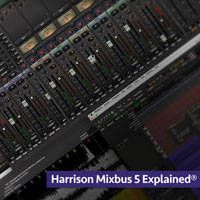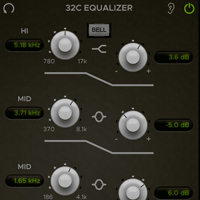The Harrison of Digital Audio Workstations
With dozens of DAWs to choose from, thereʼs only one thatʼs designed to work like a Harrison, with an analog paradigm that embodies form, function, and sound. Where other DAWs use a computer paradigm, MIXBUS grows from Harrisonʼs distinguished 40-year heritage of platinum records and blockbuster films, such as Thriller, Graceland, and Spider-Man. MIXBUS is the first full-featured DAW with true analog style mixing.
Mixbus provides professional-level features to import or record an unlimited number of audio or MIDI tracks to your computer; then edit, mix and master your production.
What Makes Mixbus Different?
Harrison has a unique history. In the mid-80’s, we developed fully automated, digitally-controlled analog mixer technology which was adopted by premiere film-mixing facilities around the world. When the digital revolution came, we were asked to convert the analog “processor” into a digital processor, while leaving the control surface unchanged. Film mixers wanted the control surface to -work and sound- exactly like the analog mixer they were using for previous projects. This required us to develop a digital audio engine that operated and sounded exactly like the analog mixer they were using for previous projects. This transition was not undertaken by any other company, and it has provided us with techniques and proprietary technology that we have incorporated into all of our high-end mixers. Mixbus gives us an opportunity to share this technology with a much wider range of users.
Mixbus Sounds Better
Other DAWs are designed by companies with experience in computer sound, but no pedigree in world-class recording facilities. The Mixbus DSP mixer is designed by Harrison specifically for its great-sounding EQ, filters, dynamics, and bus summing. If you find a music recording from the golden age of albums - the 70s and 80s - that has stood the test of time, it is likely that a Harrison console was used during the production. Mixbus invites you to produce recordings that will stand with the very best.
Mixbus is Ultra-Compatible
Mixbus works on the three most popular desktop operating systems (Mac OS X, Windows, and Linux) in both 32 bit and 64 bit versions, and loads industry standard I/O and plug-in formats (VST, AU, & LV2). Do you collaborate with other Mixbus users? A session from a collaborator using Harrison plug-ins will playback in your Mixbus as originally recorded including full performance of all the plug-in information even if you have not purchased those specific Harrison plug-ins yourself. Sessions can be shared among Windows, Mac and Linux users.
Some Mixbus Features
- Straightforward “knob per function” mixer layout based on Harrison's renowned 32-series and MR-series music consoles
- DSP sounds based on Harrison's famous analog and digital mixing console technology
- Precision algorithms for EQ, Filter, Compression, Analog Tape Saturation, and Summing
- Unlimited stereo or mono input channels, each with unlimited plug-ins, sends, and hardware inserts. (limited only by CPU and disc speed)
- Unlimited MIDI tracks, each with virtual instrument support, unlimited plug-ins, sends and inserts
- Phase, Input trim, High-pass Filter, Sweepable 3-band EQ, Compression, and 8 Mix Bus sends on every track
- Mixbus has an optimized signal flow with 8 stereo Mix Buses and a master bus, all featuring Tone controls, Compression, Sidechaining, and Analog Tape Saturation simmulation
- Stereo Master Bus that features Tone controls, Analog Tape Saturation, K-meter, Stereo Correlation Meter, and Limiter
- Automatic plug-in delay compensation to support effects such as parallel compression without time misalignment
- Comprehensive "at-a-glance" metering with peak, peak hold, and compressor gain reduction visible on every track and bus
- Extensive DAW editing features
- Industry standard plug-in support: Mixbus loads VST plug-ins on Windows, AudioUnit (AU) plug-ins on OSX, and LV2 plug-ins on all platforms
- Industry standard audio I/O support: Mixbus uses ASIO/Directsound on Windows, CoreAudio on OSX, and JACK on Linux
- Mixbus provides features that are normally reserved for expensive products; things like LTC (SMPTE) generation and sync; video pullup/pulldown; and persistent undo (undo remains possible after closing and reopening a session.
- Multi-core and 64-bit optimizations provide dramatically increased track counts across all OS platforms
- Third-generation Harrison True Analog Mixing™ processing engine with enhanced compressor/limiter algorithms; built-in sidechain bussing, and increased plug-in flexibility
- Over 50 ‘MIDI filter’ plug-ins including functions such as transposing, velocity scaling, etc
- Experimental support for video timeline, video window, and audio+video exports
- Includes a brand-new virtual instrument: “SetBfree”, a lovingly modeled Tonewheel Organ by Robin Gareus plus Harrison's Dyno-Mite envelope-designer plug-in for drums
- The Mixbus engine is internally dithered, ramped, and gainstaged so that sound quality is preserved as close to analog as possible
- Audio regions are stacked in “layers”, and every region fadein/out is a crossfade to the region(s) beneath it
- The user interface scales to fit your monitor; larger monitors will get bigger knobs and sharper text; while small monitors (such as a laptop) will be scaled down to fit
- Refined workflow and graphics, including scaling and support for HiDPI (Retina) displays
- Incredibly cost effective because of our world-wide open source collaborators
Analog Console Feel
Engineers have been mixing on hardware consoles for more than 80 years because that’s what works. Need to make a change? grab a knob and change it. We believe that mixing inside a DAW should be no different and as easy to use as a hardware console. So we make the mixer portion of Mixbus work just like a hardware console, applying precision & proprietary algorithms to provide Harrison’s great sounding EQ, HP Filter, and Dynamics on every channel… without the need for additional plug-ins. Mixbus also provides 8 stereo aux mix busses, a stereo master bus with analog tape saturation simulation, a monitor section, and precision summing, all based on Harrison’s world-renowned large format analog and digital consoles. You can work with the fluidity of a traditional analog recording studio while retaining the convenience of a DAW.
For example, the fader area contains the input trim, fader level, compressor threshold (with meter), and compressor makeup gain. This provides the most-used gain functions within a very small "mouse travel" distance. Compare this to other DAWs which require juggling multiple windows, popups, and menus simply to navigate these most fundamental mixing features!
Metering is another aspect of DAW design that can make mixing more fluid. In the mix window, Mixbus provides the channel meter, compressor gain reduction meter, tape saturation meters, peak limiting meter, K-14 average level meter, stereo correlation meter, and a final peak limiting meter simultaneously. Compare this to other designs which require plug-ins from several manufacturers and several windows to find this important information. Mixbus provides everything you need to mix without distractions in an easy-to-use, one-window interface! Finally, mixing “inside the box” is a very sound philosophy.
Already using another DAW?
No problem. It’s a simple and quick process to export your audio files from your current DAW to Mixbus and use the exceptional Mixbus “True Analog Style Mixing” engine for your final mix. No need to change your current workflow, just add convenience, ease, and sound quality by doing all your final mixing in Mixbus.
Powerful Editing Features in Mixbus
The editing model in Mixbus has been highly refined based on our user's feedback, as well as industry standard "best practices" and includes one of the most powerful and versatile editing suites of any DAW available. "Smart" mode combines the features of timeline-based editing and object-based editing depending on the location of the mouse within the track. Mixbus allows the user to quickly "swipe" across the waveform and drag the gain level up or down. By reducing this very common task to a minimum of operations, editing in Mixbus becomes a real joy for beginners as well as professionals who have to work quickly. The timeline view provides detailed waveform and MIDI data, as well as automation points and crossfades. Editor views can be resized and re-arranged to fit your needs; and there are dozens of key commands and mouse shortcuts to speed up this process.
Many other DAWs use a hide-and-seek approach when it comes to revealing editing features. Mixbus makes the learning process much easier by providing a right-click context menu on many of the edit window elements. Want to know how you can manipulate a region? Simply right-click on it to view the contextual help.
Incredible Value
Mixbus users often ask why such a great product is so cost effective. Well, Harrison is all about providing real value to our users. While other products are bloated with buttons and features that you never use, we focus on doing all the important things right. Giving you the tools that you need to get your work done creatively and efficiently while maintaining that great “analog sound”. We consider Mixbus to be our full featured, yet entry level DAW product, serving as an introduction to the famous Harrison DSP and analog mixing quality found in all Harrison consoles and products, while also providing features that are normally reserved for the top tiers of competing products (unlimited tracks/instruments/plug-ins, 3rd party plug-in loading, controller support, timecode sync, video window, etc)
We want as many people as possible to be able to experience Harrison’s Mixbus themselves and become long term Mixbus users so we are offering this version at what we consider to be an exceptional value to you.
Our roadmap for Mixbus and associated products is long and marked with exciting new Harrison technology, software, and harware along the way. We want our users to take this journey with us. In the future, we will be talking more about where Mixbus is headed such as:
- More software versions targeted for specific workflows
- A Mixbus hardware control surface incorporating many Harrison console innovations
- Many more famous sounding Harrison plug-ins
- Film surround panning (including Atmos and Auro3D)
- Console style automation, bussing, and monitoring features including expanded mixer features (bigger EQ's, compressors, etc.)
- Specialized DSP from our film consoles (noise reduction, etc.) all the way up to full Mixbus integration into our large format consoles
We welcome you to the Harrison Mixbus family and trust your experience will be creative, rewarding, fun, and effective.



